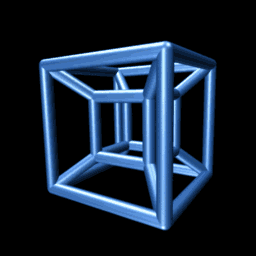

[3D projections of an 8-cell performing, on the left, a simple rotation about a plane which bisects the figure from front-left to back-right and top to bottom; and on the right, a double rotation about two orthogonal planes.]
In geometry, the tesseract, also called an 8-cell or regular octachoron, is the four-dimensional analog of the cube. The tesseract is to the cube as the cube is to the square. Just as the surface of the cube consists of 6 square faces, the hypersurface of the tesseract consists of 8 cubical cells. The tesseract is one of the six convex regular 4-polytopes.
A generalization of the cube to dimensions greater than three is called a ''Hypercube'', “n-cube” or “measure polytope”. The tesseract is the four-dimensional hypercube, or 4-cube.
According to the Oxford English Dictionary, the word tesseract was coined and first used in 1888 by Charles Howard Clinton in his book A New Era of Thought, from the Greek ''τέσσερεις ακτίνες'' (“four rays”), referring to the four lines from each vertex to other vertices. Some people have called the same figure a “tetracube”, and also simply a "hypercube" (although a hypercube can be of any dimension).


![Reblog this post [with Zemanta]](http://img.zemanta.com/reblog_c.png?x-id=7669b5e8-3621-4bb6-9870-ac6cb049fd20)




.png)





No comments:
Post a Comment